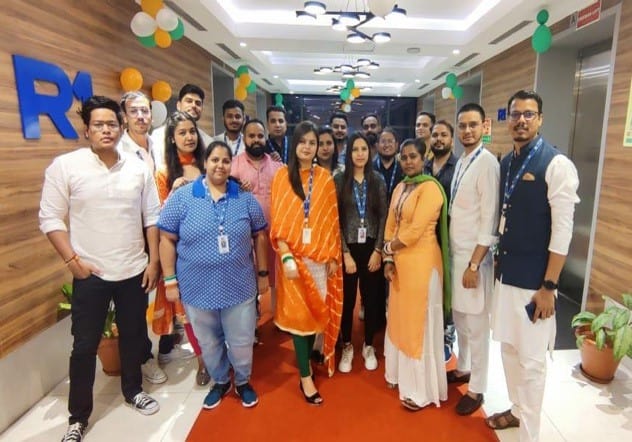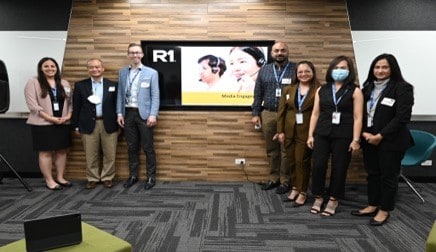While the healthcare industry continues to climb its way out of a pandemic, it’s also facing unprecedented challenges, including rising operating costs, labor shortages and shrinking margins. What if there was a global delivery model that could help the industry during this challenging time?
According to a recent data-based survey report from R1 RCM, the healthcare labor shortage is not limited to clinical staff. In this survey, 90% of healthcare executives said they are experiencing a workforce shortage in RCM, with many of those reporting vacancies in over half their RCM roles. This is one of the many reasons why now is a good time for health systems to think outside the box for solutions that include RCM partnerships and global delivery.
More healthcare leaders are outsourcing RCM to a partner with global-delivery capabilities.
Revenue cycle global delivery occurs when select functions of the revenue cycle are performed in offices overseas, allowing RCM companies to keep their solutions flexible and scalable, so health professionals can focus on what is important — excellent patient care. While this may have been an obstacle in the past, the majority of healthcare executives have warmed to the idea of global delivery. In fact, over 80% of finance and revenue cycle leaders say their sentiment toward global delivery has become more favorable in the face of today’s labor shortages.
However, as in all aspects of business, there are ways to do global delivery well, and pitfalls to avoid. We’ve gathered five of the top global-delivery myths to show how it can provide benefits to all parties when done well. Let’s bust some myths!
Myth 1: Global delivery creates disjointed teams and collaboration.
Teamwork, communication and collaboration should always be at the center of all revenue cycle global-delivery efforts. While this does require more effort when separated by time zones, it is absolutely possible to work collaboratively to resolve issues, solve client problems and engage best practices for continuous improvement with remote teams.
The way to realize this is having an RCM partner that keeps global delivery within its own company. This model — as opposed to when a rev cycle partner contracts outside of its organization with a party overseas — allows associates worldwide to work as one.
At R1, our teams share the same company culture and mission — making healthcare simpler and ensuring success for our clients. We do this by following the R1 Way, which defines our commitment to essential, shared, everyday behaviors that empower associates to succeed. By offering similar office experiences, opportunities for advancement, paid volunteer hours, training opportunities and more, our onshore and offshore teams share similar work experiences that fuel engagement, teamwork and collaboration.
As with other domestic employees who are now working remotely post-pandemic, our global revenue cycle teams regularly communicate and collaborate via video conferencing to share best practices, processes and standards. The majority of our global associates work evening and night shifts, so their schedules align with their US counterparts, which allows for frequent, real-time collaboration and problem-solving. Additionally, all global team members work in the same technology systems. This allows our associates to experience consistent workflow allocation and communication, which results in seamless hand-offs and continuity among teams.

Myth 2: Global delivery is less secure.
Health system decision-makers can be deterred from RCM partnerships — especially those that use global delivery — because of concern that the new party will not guard data in the same, secure way. However, when dealing with anything in healthcare, security should always be a top priority. In fact, responsible and reliable RCM partners make it a priority to keep not only their own operations secure, but leverage those same security measures and resources to keep their partners’ data equally protected.
The first step in ensuring security when using global delivery is to make sure the RCM company you partner with holds all team members to the same high standards and processes, no matter where they are located. Once again, this can be tied back to an RCM partner keeping global delivery within its own company where all team members utilize best-of-breed tools and industry-standard processes to maintain high standards for HIPAA compliance, data security and regulatory compliance. This preferred model reduces security risks, addresses dynamic threats and meets customer and compliance obligations as security measures, standards and processes can be maintained under one umbrella.
Because cybersecurity is everchanging, we are continuously reviewing our systems and improving our data safeguards by implementing new tools that help us monitor and mitigate risks. These proactive measures are always taken at all our locations — onshore and offshore — to ensure a high level of data security.
New Data-Packed Report Now Available
If you’re looking for key trends, data insights and clear-cut examples of how technology plays a role in building a strong RCM process, download our exclusive report now.
Myth 3: Global delivery only focuses on cost savings.
Due to the growing problem health systems face with shrinking margins, cost savings is a core component to offshore RCM. However, the most successful global-delivery models place equal importance on effectively managing costs and successful client outcomes.
At R1, we scan the globe to open RCM work centers in the right places that have the skills we need to provide continuous best-in-class solutions and services. Yes, this means growing our teams in developing economies where we are able to more effectively manage costs, but we do so while thoroughly evaluating locations and their many attributes, including identifying broad talent pools.
Evaluating the attributes of numerous global locations is a big task. In fact, in 2021 when R1 first began choosing a location for a new global office, we created a long list of approximately 25 possible locations, and then slowly narrowed down the list after measuring 19 key attributes. These attributes prioritized items such as language proficiency, clinical skills, security, cultural values, natural disaster risk, location sustainability, legal and regulatory environment, and travel accessibility.
While the location attributes were being thoroughly vetted, choosing an area with plenty of top RCM talent was also a primary consideration. We were seeking an area with a large base of highly educated and tech-savvy professionals.
Any health system seeking an RCM partner that utilizes global delivery should ask questions about how global office locations are chosen. Doing so can ensure long-term, global-delivery success, not just short-term savings.
Myth 4: Language and cultural differences cause barriers in successful RCM global delivery.
The most successful global-delivery systems always take cultural and language differences into account. By blending proper planning and attention to detail, most all differences can be overcome — and even embraced.
When first starting out, it’s important to focus on what your primary needs are and choose a market based on those needs. For example, if customer service phone work will be a large part of the global-delivery operation, it’s important to look for countries with neutral accents and a high rate of English- and Spanish-speaking workforce members. In a case such as this, there are several types of language tests that can be administered to evaluate a candidate’s speaking and language-proficiency skills. If customer service phone skills are not a requirement, additional global markets may be considered — and even better suited.
The way to best remove language and cultural barriers ties back to myth three and the importance of choosing a global location based on the outcome you are trying to achieve. In other words, if you are looking to partner with an RCM company who utilizes global delivery, do your homework to make sure they have a presence in the right market for what you want to accomplish.

Myth 5: Global delivery steals domestic jobs.
No American-based company wants to take jobs away from American workers, and it’s important to remember first and foremost that reputable RCM companies who utilize global delivery do not “send jobs overseas” without thoughtful consideration of the entire business model. It’s also important to remember that in almost all ways of rolling out a global-delivery model, there is a mix of US-based work and work happening overseas.
Within the R1 global-delivery model, there is always an onshore RCM contingent that works the most complex cases, including escalations. This ensures the highest-level work stays here for proper consideration, follow-up and troubleshooting by our US-based employees.
Conversely, our less-complex revenue cycle work goes to our global offices, and includes AR follow-up, billing and coding. These types of jobs are more sought after in the global marketplace than they are in the US. In fact, as the US faces a healthcare labor shortage in both clinical and non-clinical roles, more and more US-based companies and health systems are struggling to fill these types of RCM positions.
In our recent survey of more than 200 health systems and physician group CFOs and revenue cycle VPs in the US, nearly half reported they are experiencing a severe RCM shortage, with 50% of their revenue cycle/billing roles currently vacant. As patient volumes rise and RCM positions remain unfilled, administrative burdens increase, billing errors increase, and hold times for scheduling and customer service calls increase. Global delivery can assist in filling RCM roles that health systems are having a hard time filling themselves.
What does this all mean?
The financial difficulties the healthcare industry is facing are driving a need for both digital and cultural RCM transformation, which can lead to better outcomes for staff and patients alike. The best way for health systems and physician groups to address these challenges is to focus on optimizing in every way they can: investing in people, processes and technology, and embracing an open mind regarding partnerships, employee reallocation and global delivery.
When you avoid the pitfalls of RCM global delivery, you can open up the possibilities — from finding new types of talent and solving a labor-shortage issue — to new delivery methods and long-term cost management.
Read more.
Want more information on choosing a revenue cycle partner? Download the research brief, Vetting the Right Revenue Cycle Partner, published by The Health Management Academy.




